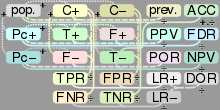Matthews correlation coefficient
The Matthews correlation coefficient is used in machine learning as a measure of the quality of binary (two-class) classifications, introduced by biochemist Brian W. Matthews in 1975.[1] It takes into account true and false positives and negatives and is generally regarded as a balanced measure which can be used even if the classes are of very different sizes. The MCC is in essence a correlation coefficient between the observed and predicted binary classifications; it returns a value between −1 and +1. A coefficient of +1 represents a perfect prediction, 0 no better than random prediction and −1 indicates total disagreement between prediction and observation. The statistic is also known as the phi coefficient. MCC is related to the chi-square statistic for a 2×2 contingency table
where n is the total number of observations.
While there is no perfect way of describing the confusion matrix of true and false positives and negatives by a single number, the Matthews correlation coefficient is generally regarded as being one of the best such measures.[2] Other measures, such as the proportion of correct predictions (also termed accuracy), are not useful when the two classes are of very different sizes. For example, assigning every object to the larger set achieves a high proportion of correct predictions, but is not generally a useful classification.
The MCC can be calculated directly from the confusion matrix using the formula:
In this equation, TP is the number of true positives, TN the number of true negatives, FP the number of false positives and FN the number of false negatives. If any of the four sums in the denominator is zero, the denominator can be arbitrarily set to one; this results in a Matthews correlation coefficient of zero, which can be shown to be the correct limiting value.
The original formula as given by Matthews was:[1]
This is equal to the formula given above. As a correlation coefficient, the Matthews correlation coefficient is the geometric mean of the regression coefficients of the problem and its dual. The component regression coefficients of the Matthews correlation coefficient are Markedness (Δp) and Youden's J statistic (Informedness or Δp').[2][3] Markedness and Informedness correspond to different directions of information flow and generalize Youden's J statistic, the deltap statistics and (as their geometric mean) the Matthews Correlation Coefficient to more than two classes.[2]
Confusion matrix
Sources: Fawcett (2006), Powers (2011), and Ting (2011) [4] [2] [5] |
Let us define an experiment from P positive instances and N negative instances for some condition. The four outcomes can be formulated in a 2×2 contingency table or confusion matrix, as follows:
| True condition | Accuracy (ACC) = Σ True positive + Σ True negative/Σ Total population | |||||
| Total population | Condition positive | Condition negative | Prevalence = Σ Condition positive/Σ Total population | |||
| Predicted condition |
Predicted condition positive |
True positive | False positive (Type I error) |
Positive predictive value (PPV), Precision = Σ True positive/Σ Predicted condition positive | False discovery rate (FDR) = Σ False positive/Σ Predicted condition positive | |
| Predicted condition negative |
False negative (Type II error) |
True negative | False omission rate (FOR) = Σ False negative/Σ Predicted condition negative | Negative predictive value (NPV) = Σ True negative/Σ Predicted condition negative | ||

 |
True positive rate (TPR), Recall, Sensitivity, probability of detection = Σ True positive/Σ Condition positive | False positive rate (FPR), Fall-out, probability of false alarm = Σ False positive/Σ Condition negative | Positive likelihood ratio (LR+) = TPR/FPR | Diagnostic odds ratio (DOR) = LR+/LR− | F1 score = 2/1/recall+1/precision | |
| False negative rate (FNR), Miss rate = Σ False negative/Σ Condition positive | True negative rate (TNR), Specificity (SPC) = Σ True negative/Σ Condition negative | Negative likelihood ratio (LR−) = FNR/TNR | ||||
Multiclass case
The Matthews correlation coefficient has been generalized to the multiclass case. This generalization was called the statistic (for K different classes) by the author, and defined in terms of a confusion matrix [6] .[7]
When there are more than two labels the MCC will no longer range between -1 and +1. Instead the minimum value will be between -1 and 0 depending on the true distribution. The maximum value is always +1.
See also
- Phi coefficient
- F1 score
- Cramér's V, a similar measure of association between nominal variables.
- Cohen's kappa
References
- 1 2 Matthews, B. W. (1975). "Comparison of the predicted and observed secondary structure of T4 phage lysozyme". Biochimica et Biophysica Acta (BBA) - Protein Structure. 405 (2): 442–451. doi:10.1016/0005-2795(75)90109-9.
- 1 2 3 4 Powers, David M W (2011). "Evaluation: From Precision, Recall and F-Measure to ROC, Informedness, Markedness & Correlation" (PDF). Journal of Machine Learning Technologies. 2 (1): 37–63.
- ↑ Perruchet, P.; Peereman, R. (2004). "The exploitation of distributional information in syllable processing". J. Neurolinguistics. 17: 97–119. doi:10.1016/s0911-6044(03)00059-9.
- ↑ Fawcett, Tom (2006). "An Introduction to ROC Analysis" (PDF). Pattern Recognition Letters. 27 (8): 861–874. doi:10.1016/j.patrec.2005.10.010.
- ↑ Ting, Kai Ming (2011). Encyclopedia of machine learning. Springer. ISBN 978-0-387-30164-8.
- ↑ Gorodkin, Jan (2004). "Comparing two K-category assignments by a K-category correlation coefficient". Computational biology and chemistry. Elsevier. 28 (5): 367–374.
- ↑ Gorodkin, Jan. "The Rk Page". The Rk Page. Retrieved 28 December 2016.